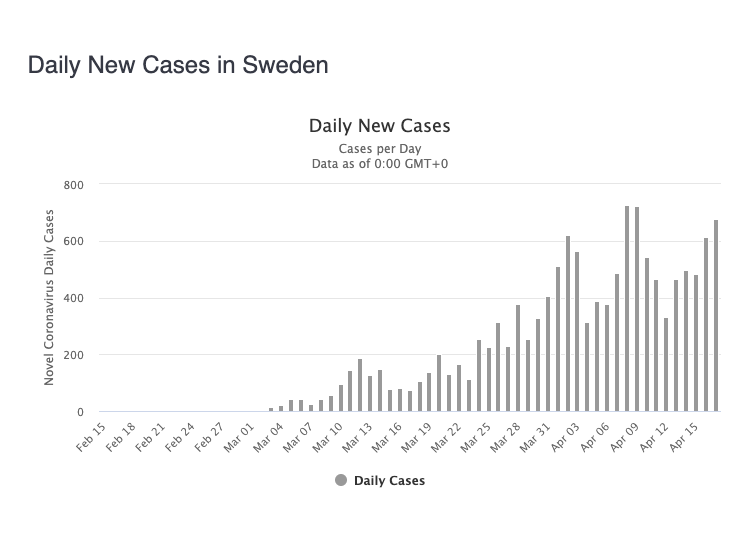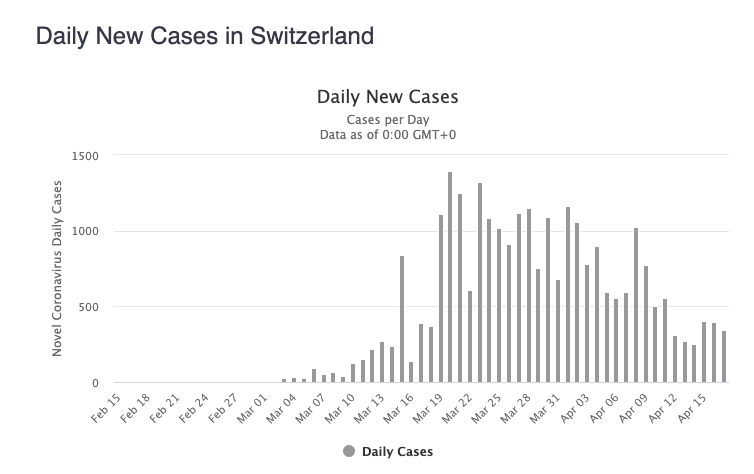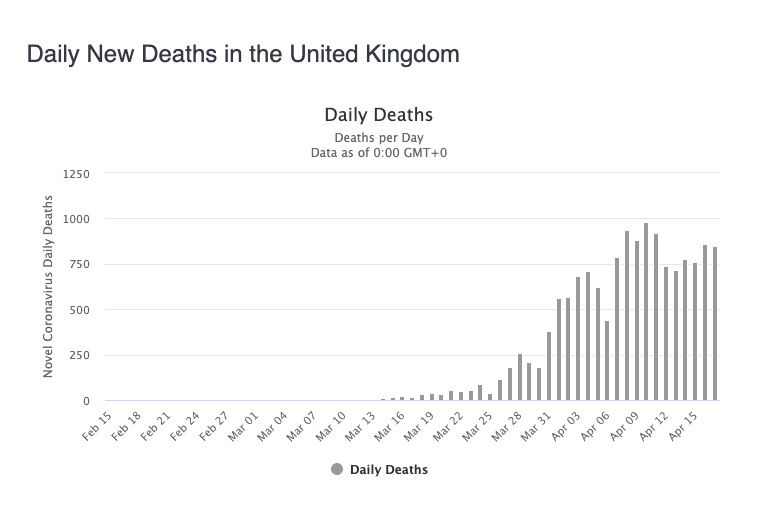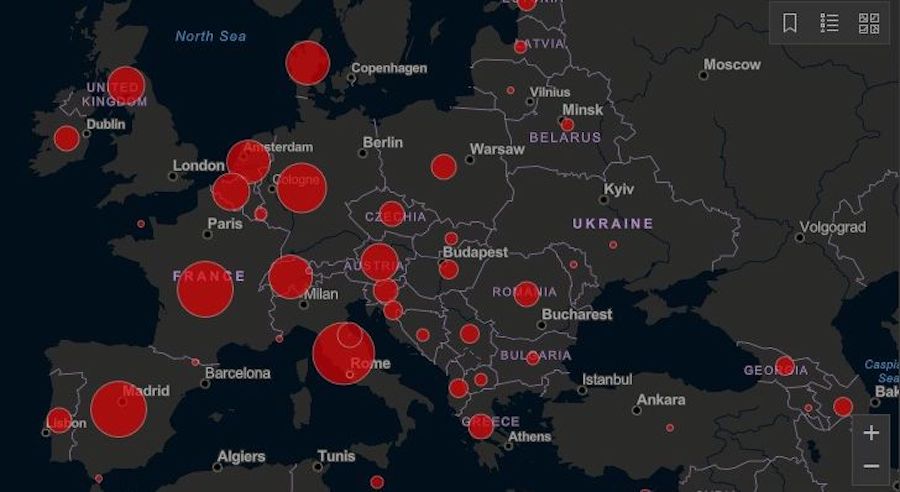Republic of Ireland
Ireland entered a painful phase of the COVID-19 epidemic at the beginning of the month. On 2 April, Ireland reported a spike in new cases in 24 hours at 402, up almost 25 percent from a previous hight of 325 on 31 March. Then on 2 April, new cases set another record, 424 in 24 hours before dropping back to 331 on 4 April.
Then boom – on 10 and 11 April, Ireland set two records for new cases in 24 hours, with 1,515 on 10 April, dropping about 40 percent to 839. You get the idea … trends were going the wrong way, with Ireland in the middle of the pandemic.
Deaths in 24 hours were declining since 36 on 7 April – 60 percent above the previous high of 22 on 3 April . But then on 19 April, deaths spiked at a record 77, though the trend line for new infections indicate Ireland has passed the peak of the pandemic.
Ireland actually has responded quickly and its strong research, pharmaceuticals and medtech sectors are racing to come up with innovative solutions to the pandemic. Republic officials are assuring the public there are sufficient supplies of medicines and that patients don’t have to ration prescription drugs, according to the BBC.
On 5 April, caretaker Irish Prime Minister Leo Varadkar, who’s a medical doctor, announced he would volunteer at least one session per week, working as a physician in his fields of expertise. Varadkar has stated Ireland is making progress in slowing the disease, adding that all sporting events are cancelled through 19 April.
The good news, so far, a minority of cases have required intensive care. That could be because the median age of victims is 47, far below other countries. Even so, the government is readying a financial package to cover lost wages.
Total reported cases: 15,652, up an aggregate of 4,558 percent from 336 on 18 March
Total deaths: 687, up 7,533 percent from 9 on 26 March
Total patients recovered: 77, up from 5 on 2 April

Spain
El Pais in English has a post, “Spain will slowly return to normal life April 26, says government.” Other media report that on 11 April, Spain reported the lowest number of deaths – 525 – in two weeks. Which is pretty amazing considering where the country was … and where it needs to be. And if you want to quantify what emerging from a pandemic looks like, check out the chart above comparing deaths versus recovered patients.
Unfortunately, the country recorded a spike in cases on 15 April, with 6,599 new infections, according to Bloomberg, the highest rate since 8 April.
Spanish officials extended the state of emergency to 25 April. But manufacturing, construction and some service workers returning to work under new guidelines, according to the BBC.
Try to get your head around what happened in Spain: During the March alone, Spain went from 9 cases to 95,923, and from zero deaths to almost 8,464. The New York Times has a deep dive into how that happened, “Spain’s Coronavirus Crisis Accelerated as Warnings Went Unheeded.”
Spain has overtaken Italy and France in number of cases and deaths, with the majority of cases in Madrid. German expat Inka Piegsa-Quishotte has an account of lock-down life in her small resort city on Spain’s Costa Blanca, where she says the pandemic has sucked the joy out of daily life.
But as of early April, the numbers are improving, or at least stabilizing, with Spain recording the fewest new coronavirus cases in a 24-hour period – 1,536 on 20 April – since 14 March.
Spain reported its highest number of deaths in one day at 961 on 2 April though that number fell to 318 on 16 April, marking five straight days of declines since 1 April. The trend for April is an average of less than 5,000 new cases each day.
Health officials believe the week of 23 March will go down in record keeping as the peak of the pandemic in Spain. “We are approaching the period in which perhaps, if we are lucky, we will turn the curve, stabilize and it’ll start to go down,” said Fernando Simon, director of the Spanish Coordinating Centre for Health Alerts and Emergencies, said Sunday.
On 19 March, Madrid Regional President Isabel Díaz Ayuso said eight out of 10 people in the Spanish capital will get COVID-19, according to CNN. While most will have mild symptoms, about 15 percent of the population is at risk for severe effects.
Earlier, authorities suspended flights between Spain and Italy, and in regions with the most cases – Madrid, Basque Country and La Rioja –ordered schools, universities and daycares closed until April.
Number of reported cases: 200,210, up an aggregate 3,033 percent from 6,391 on 14 March
Number of deaths: 20,852, up an aggregate 10,539 percent from 196 on 14 March. Spain has 446 deaths per million in population, with only Belgium exceeding that number, with 503 deaths per million in population.
Number of recovered patients: 80,587, up about 15,000 percent from 530 on 17 March

Sweden
In early April, Swedish Prime Minister Stefan Löfven was warning thousands will die from COVID-19 and there are dozens of posts in the international media questioning the country’s approach, which is to leave everything open and trust Swedes will do the right thing.
Swedish officials are holding the course and promising the herd-immunity tipping point is just mere weeks away. That is, almost everyone in the country will have the antibodies and be immune.
The result is, Sweden – unlike most countries in Europe – shows very little statistical flattening of the rate of infection (See the above chart) though deaths have fallen precipitously.
To be fair, trend lines had been improving markedly since 2 April, with daily new cases dropping to 312 on 4 April from a record of 621, and deaths in a 24-hour period decreasing to 15 on 4 April.
Then, the number of new cases reported in 24 hours spiked to 726 on 8 April, retreating to about 500 by 14 April. But deaths rose to 170 on 15 April, the historic high.
Sweden increasingly is being criticized for its laissez-faire approach, with voluntary compliance and businesses including pubs are open. Authorities reassessed their strategy in early April, but promptly decided to keep on doing what they’re doing.
The Scandinavian country only recorded its first coronavirus death on 11 March. And yes, the country has closed universities, with classes on-line, and government officials have advised Swedish citizens not to travel to Spain and other virus hotspots and to avoid non-essential travel.
But, the rest of the public school system remains open. Close the borders? Nah …. What about restaurants, pubs and cafés? “No, way, dude.”
The result? As other countries’ infection and death rates were flat-lining, Sweden was reporteing its largest number of new cases in a 24-hour period on 8 April at 726, up 42 percent from the previous high of 512 on 28 March. Then, the death rate spiked to 170 on 15 April, up more than 120 percent from the previous high of 76 on 6 April. The Jewish community in Stockholm has been particularly hard hit with 8 deaths, all people over 80 years old including several Holocaust survivors.
At this point, it has relatively few cases and deaths, so who knows … and the Guardian has the best account of those lazy, crazy days of spring in Stockholm.
Number of reported cases: 14,777, up an aggregate 1,438 percent from 961 on 14 March
Number of deaths: 1,580, up 79,000 percent from 2 on 14 March with a relatively high number of deaths per million of population at 156, almost three times higher than Germany’s rate of 58
Number of recovered patients: 550, up from 1 on 14 March

Switzerland
Switzerland joins Austria, Denmark and other countries in leaving behind the pandemic after trend lines improved dramatically in April. On 4 April, Switzerland reported the largest 1-day death total of 75. That rate decreased more than 66 percent to 25 on 19 April. New cases dropped to 204 on 20 April from a peak of 1,393 on 20 March.
On 14 April, Swiss Federal Council officials announced a 3-step transition back to normal:
• On 27 April, hospitals will be able to resume all medical procedures, including non-urgent procedures, and outpatient medical practices. Salons, massage practices and cosmetic studios will reopen, along with DIY stores, garden centres and florists also will reopen. Restrictions on the range of products sold at supermarkets will be lifted.
• On 11 May, Phase 2 will see schools, shops and markets reopen. The Federal Council will decide on whether to proceed with phase two on 29 April.
• Phase 3 will start 8 June with upper secondary schools, vocational schools and higher education institutions resuming face-to-face teaching. Entertainment and leisure establishments such as museums, libraries, botanical gardens and zoos may reopen, and restrictions on gatherings could be relaxed.
The Federal Council will take a decision regarding the details of this phase on 27 May.
Though Switzerlands has half the population of, say, the Netherlands, it had almost 40-percent more confirmed coronavirus cases as of the end of March, with 120 deaths per million in population, among the six highest in Europe.
The Alpine country is now testing 16,000 people per day, according to the New York Times. Swiss Health Minister Alain Berset predicts the pandemic will crest in Switzerland by early summer, according to the New York Times, and that extraordinary measure will stay in place.
Only recently did the Swiss institute nation-wide rules with schools closed and and gatherings of more than 100 banned. The border with Italy is also tightly controlled, but cases spilled over from Italy, according to Reuters, threatening to overwhelm hospitals in the Swiss canton of Ticino, which has ordered seniors not to leave home.
On Sunday, 22 March, the Swiss government authorized calling up as many as 8,000 military reservist to assist in the crisis, which means calling up ordinary citizens since the country’s population is its standing army.
On Monday, 16 March, restaurants, museums, cinemas, hair salons, and all nonessential commerce are shut down until at least 19 April, according to CNN.
Number of reported cases: 27,944, up an aggregate 1,932 percent from 1,375 on 14 March
Number of deaths: 1,429, up an aggregate 10,892 percent from 13 on 14 March with a deaths per million in population rate of 165.
Number of recovered patients: 18,600, among the highest percentage in Europe

United Kingdom
Before COVID-19 put Prime Minister Boris Johnson in the ICU – and Dominic Raab in charge (sort of) – on 6 April, critics on the left, right and center were beating Boris up for his lackadaisical response to the pandemic and lack of any plans whatsoever for testing. Even the normally loyal Telegraph, where Johnson was a columnist for years, has a scathing story about the government’s “systemic failures” in dealing with the pandemic.
Only in the third week of March did Britain finally join the rest of Europe in announcing a lock-down. On Sunday, 22 March, Johnson instituted a “stay at home lockdown,” ordering all shops closed other than supermarkets and pharmacies until at least mid-April. Gatherings of more than two people are banned, according to Sky News.
All to no avail.
The UK went from having 36 cases on 1 March to 25,550 cases by 31 March. Those were the good old days.
As of 10 April, Britain joins Sweden (and the Netherlands to a lesser extent) as the only countries in Europe that show little “flattening,” the term for a decreasing rate of infections, setting a 1-day total in new cases – 8,681 – on 10 April, along with the highest number of deaths in 24 hours at 890.
Though no one really knows because reporting in the UK is seriously flawed, with far more deaths than reported because testing is minimal. No one knows how many people have died as British authorities apparently haven’t released nursing homes in their statistics.
With British epidemiologist and mathematician Neil Ferguson predicting as many as 20,000 deaths in the UK, the government – with support from Labour – is considering banning all outdoor exercise.
The media is dissecting an infection model created Oxford researchers that estimates half the population of the United Kingdom is infected, finding that far fewer people are developing serious symptoms than had previously been predicted. But unlike other countries, the UK is struggling event to test its own healthcare providers at a time when the National Health Service is still in danger of being overwhelmed, with an economy already weakened by Brexit and austerity programs.
Chancellor of the Exchequer Rishi Sunak already has announced the government will pay 80 percent of wages for employees who are unable to work — up to 2,500 pounds per month, according to CNBC.
As with most of Europe (if the UK is still considered part of Europe), Britain is old, with 12 million people 65 and over; 3.2 million people 80 and over and 1.6 million people 85 and over, according to Statista. So, roughly somewhere around 20 million people – almost one-third of the entire 66 million population – fall in the demographic most vulnerable to COVID-19.
Early in the pandemic, the UK was diverging radically from the approaches of most countries, with the Johnson government’s chief science advisor recommending the majority of Brits catch the virus in order to give the nation “herd immunity” to stop future outbreaks.
However, on Saturday, 14 March, Johnson reversed the policy, instituting a ban on sporting events, concerts and other mass gatherings after an early spike in deaths, according to Sky News.
The government has a new website with the latest details about coronavirus.
Number of confirmed cases: 124,743, up an aggregate 10,842 percent from 1,140 on 14 March (includes all UK territories)
Number of deaths: 16,409 (official), an aggregate 78,038 percent increase from 21 on 14 March. This figure is likely a 33-percent undercount
Number of patients recovered: No one knows














